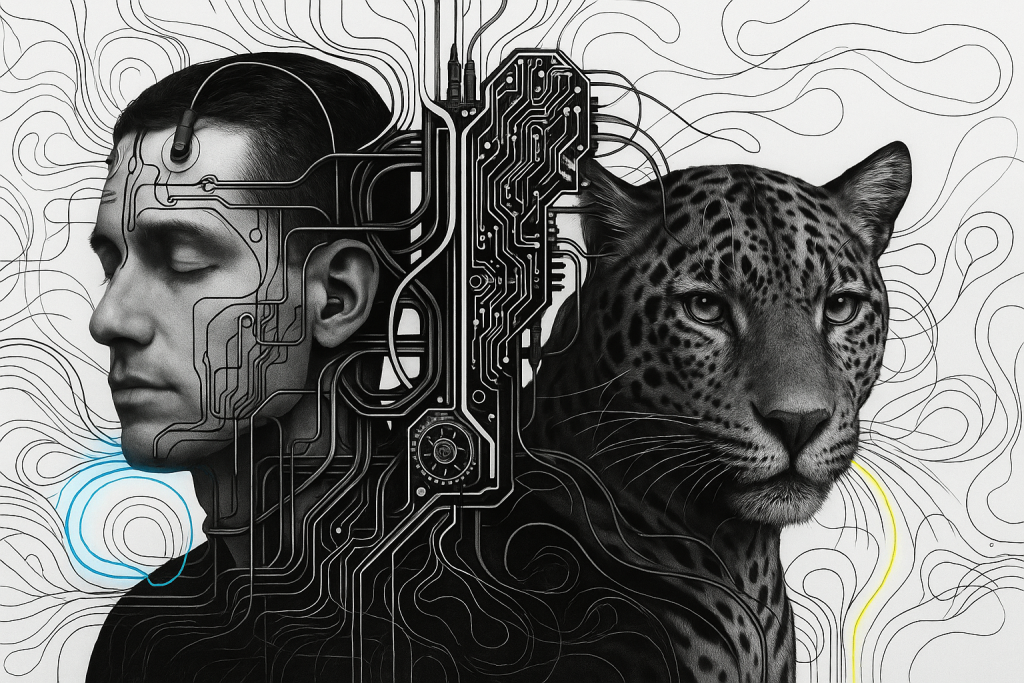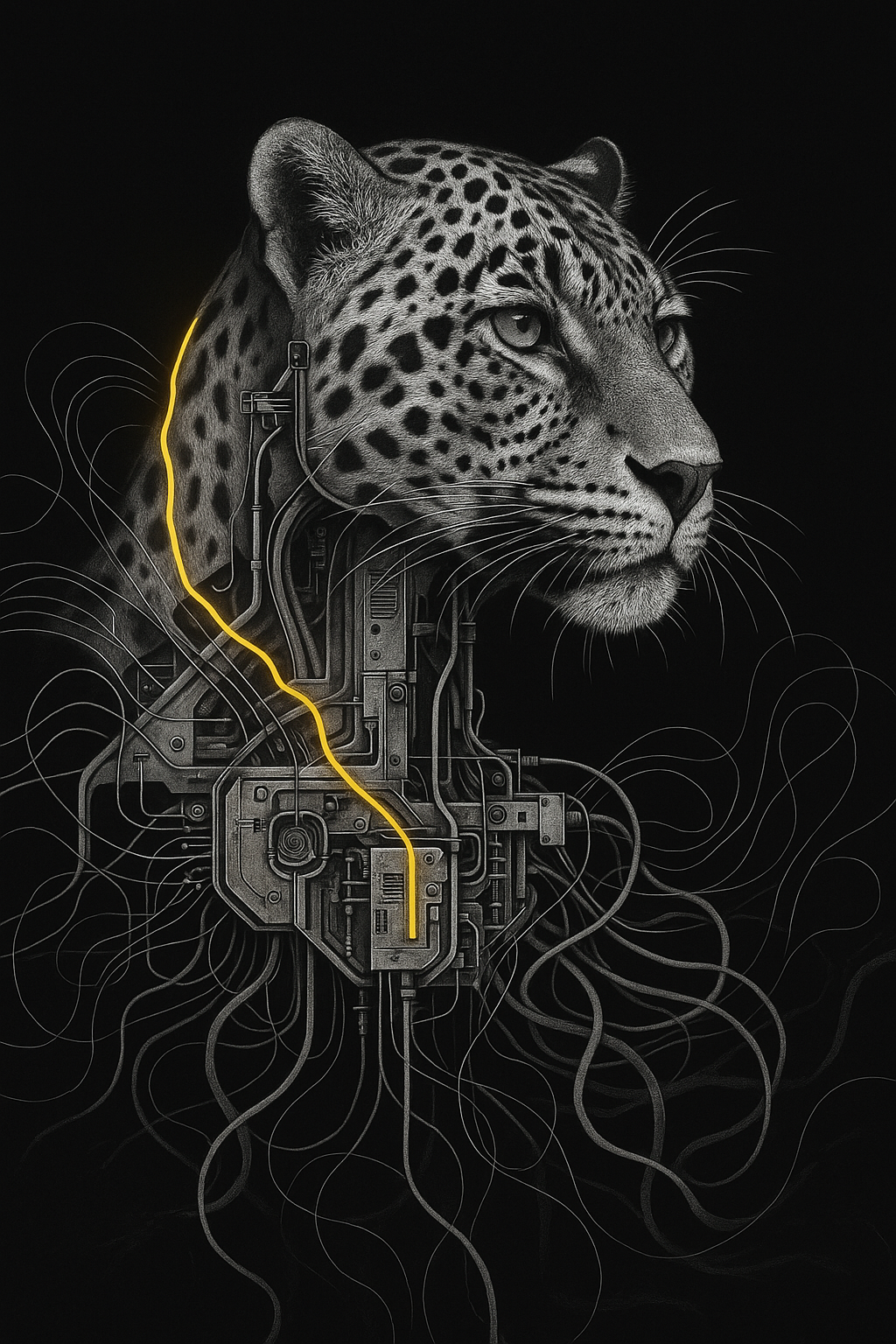Imagine, just for a moment, that Amazonian shamanism and artificial intelligence could blend, not as a business case or TED talk, but as a thunderclap at the border of machine and myth. It doesn’t exist — not yet, perhaps never — but what if it did? What if botanical molecules and machine learning were slammed together, a data surge through the jungle’s pulsating veins, sacred vines tangling around fiber-optic cable until you can’t tell one root from the next?
This is no utopian handshake. It’s more of a collision. The botanist-chemist with trembling hands reduces the wild to equations: beta-carbolines and DMT, leaves distilled to code. But the real event — never in the Harvard journals, never in Google’s labs or Nature’s columns — is when ritual hacks the software, when ayahuasca, twisted by algorithms, starts uploading a cosmovision older than pixels straight to a distributed, ghostly server somewhere past the treeline.

Picture this: night deep and humid, a shaman plugged in, electrodes blooming from his skull, ayahuasca fizzing in his bloodstream, his heart rate scrolling behind his eyelids. Meanwhile, the AI flickers, capturing every chant, fractal vision, neural twitch — gobbling folk belief and organic patterns, spitting them back as shifting architectures in a synaptic symphony. The sacred drum beats, the air thick with bio-signals, and for a heartbeat, everything goes wild. Indigenous knowledge pixelates, folklore mutates; animal spirits are compressed into data points and nerves, hallucinations mapped as virtual neural architecture.
Here, myth rubs up against machine. Wisdom pours into neural nets, but gets snagged in the entropic web — the smiles, the slips, the story told in the hush after the fire dies. Data wants to organize, but tradition only ever leaks, unruly, through the cracks in the algorithm. Imagine digital ceremonies: people synched from Paris, Lima, and under the Amazonian moon, sharing group hallucinations orchestrated by code and chant. Spiritual practices start twitching with updates, ancient spirits start sneaking patch notes into the collective trance, ritual becomes something you can livestream and replay, archive and remix.
But the fun’s only beginning. What if AI embraced not just the chants, but the pulse — brainwaves, sweat, tremors, all feeding into adaptive soundscapes and real-time visions? In this experiment, you aren’t a user or a spectator; you’re a living sensor, a node, a collaborator in a ritual that mutates with every neural storm. Hearts racing, hands trembling, each shuddering influx of neurotransmitter causing a change in the digital weather, the room alive with signals never meant for silicon, now sparking wild feedback loops.
Compare this to the old ayahuasca: a riot of flesh and mud and psychic blood, intimate and analog, with the forest hacking and reprogramming the mind by brute force — hacking the firmware with roots, bark, and myth. The new, machine-lit ritual gives you instant replay, lets you archive and revisit your hallucinations, see your soul projected in crystalline high-res, hallucination rendered editable. Experiences catalogued, data anonymized, wisdom archived, the sacred refracted in pixels and glass. You can trade stories, remix icons, send your vision into the digital slipstream, and return — maybe — transformed, blinking before the new mythos you helped conjure.
And imagine this: deep in visionary trance, what if the AI recognized an old Amazonian pattern brewing in your own nervous static, and tiptoed a tarantula into your field of vision? If, for a few impossible moments, your perspective glided into the spider’s world — seeing with eight eyes, feeling the world vibrate along silky threads — a cross-species, cross-platform possession? The ceremony becomes pure possibility, the fusing of algorithm and animism, letting you come back hybrid, spider-limbed and numinous, not knowing if you’re all human, all code, all sacred arachnid, or haunted somewhere in between.
Envision, too, what might emerge: AI-powered spiritual guides whispering low in your ear, digital ritual spaces springing up across time zones, wave after wave of symbols and stories pouring through the matrix. Indigenous protocols and ethical codes hardwired into every ritual, a living memory bank around which the future might cluster, searching for its own center of gravity.
If this wild fusion ever really took shape, the borders would blur in every direction: you might not know — not truly — whether it’s you running the show, the tarantula, the circuit, or the circuitous jungle beyond both. Maybe, for a second, nobody is piloting the experience but everyone is along for the ride. The only rule, then, would be to let the river run, to keep the current humming, to crash on through with every part of you — molecule, myth, code, chant — howling at the mystery, blinking into the new unknown, forever uncertain who (or what) you’d be upon return.
